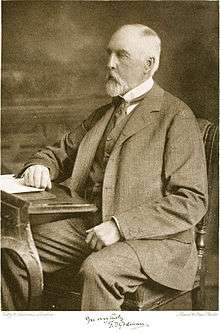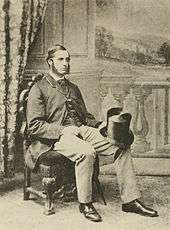Frederick DuCane Godman
| Frederick DuCane Godman | |
|---|---|
 | |
| Born |
15 January 1834 Park Hatch, Godalming, Surrey, United Kingdom |
| Died |
19 February 1919 (aged 85) 45 Pont Street, S.W. London |
| Resting place | Cowfold, Sussex, United Kingdom |
| Residence | South Lodge, Lower Beeding, Sussex |
| Citizenship | United Kingdom |
| Nationality | English |
| Fields | lepidopterist, entomologist, ornithologist |
| Known for | Founding British Ornithological Union |
| Notable awards | Linnean Medal (1918) |
| Author abbrev. (botany) | Godm. |
| Spouse |
1. Edith Elwes (m. 1872) 2. Alice Mary Chaplin (m. 1891) |
| Children |
Eva Mary (1895-1965) Catherine Edith (1896-1982) |
Frederick DuCane Godman DCL FRS FLS FGS FRGS FES FZS MRI FRHS (15 January 1834 – 19 February 1919) was an English lepidopterist, entomologist and ornithologist. He was one of the twenty founding members of the British Ornithologists' Union. Along with Osbert Salvin, he is remembered for studying the fauna and flora of Central America.
Godman collected Iznik, Hispano-Moresque and early Iranian pottery. His collection of more than 600 pieces was donated to the British Museum through the will of his younger daughter, Catherine Edith Godman, who died in 1982.[1]
Early life and Cambridge years
Frederick Godman came from a wealthy family. He was the third son of Joseph Godman who was a partner in the brewery firm Whitbread & Company. Frederick was sent to study at Eton College in 1844 but left three years later due to poor health and was educated at home by private tutors.[2] At the age of 18 he went with his tutor on a trip around the Mediterranean and the Black Sea visiting southern Spain, Athens and Constantinople.[3]
Godman joined Trinity College, Cambridge in 1853 where he met Alfred Newton and Osbert Salvin. Both Salvin and Godman spent time learning to skin and mount birds at Baker's taxidermy shop on the Trumpington Road. They also spent time in the field on the fens. The custom of these ornithological friends (and his brother Percy) to meet and talk over their recent acquisitions led to the idea of an organisation and the foundation of the British Ornithological Union. At a meeting in Alfred Newton's room in Magdalene College on 17 November 1858, a group that included Godman, Salvin, Wilfred Simpson, John Wolley, Philip Sclater and others decided that "... an Ornithological Union of twenty members should be formed, with the object of establishing a new Journal devoted to Birds: that Lieut.-Colonel H. M. Drummond should be President, Professor Newton the Secretary of the Union, and P.L. Sclater should edit the Journal: that the title of the Journal should be The Ibis."[3] Godman inherited a fortune from his father that allowed him to travel the world.[2][4]
Travels
In 1857 Godman and his brother Percy visited Bodø in northern Norway. They later published an account of their visit in the Ibis.[5][6] In 1861 he joined Salvin (who was making his third trip to South America) in a trip to Guatemala and Belize via Jamaica. Godman left Salvin in Belize due to a fever and returned home via the Atlantic coast. In 1865, he made a trip to the Azores with his brother Captain Temple Godman. In 1871 he visited the Canary and Madeira Islands.[6] He corresponded with Charles Darwin.[7] He made many other trips later including a trip to India in 1886 with Henry John Elwes. They visited Bombay, Delhi, Allan Octavian Hume at Simla, Calcutta and then travelled east to Sikkim. He purchased a collection of butterflies from Dr Robert Lidderdale (1835–1908). During this trip he had trouble walking particularly at high altitudes. They returned through Madras and Sri Lanka. Later on he had a blood clot in the veins of his legs, leading him to move and live in the warmth of Mexico in 1885. Even here he joined Elwes on a trip up Popacatapetl.[3][6]
Life and work

Godman and Salvin decided to work on a project to document the fauna and flora of Central America in 1876. This monumental work Biologia Centrali-Americana (1879–1915) was to grow into a 63 volume encyclopaedia on the natural history of Central America. Some of the botanical plates were painted by Salvin's wife. Salvin did not live to see it completed. Godman relied on Salvin for much of the systematics involved. The work was made possible by a number of other collaborators including Richard Bowdler Sharpe and George Charles Champion. The associated collection was also enormous and included collections made by others such as Henry Walter Bates that were purchased. Godman and Salvin also collected numerous bird and butterfly specimens. These were presented to the British Museum in 1885, including nearly 520,000 bird skins alone. Godman also took an interest in plants, maintaining a large collection of rhododendrons, orchids and alpine plants in his garden and rockery near Horsham. This house where he lived is now South Lodge Hotel.[8] Along with his brother Colonel C. B. Godman, he took an interest in hunting with dogs, fishing and shooting.[6]
Godman collected early Iranian pottery, Iznik pottery and Hispano-Moresque ware. Although he had visited Istanbul in 1852, the ceramics were purchased in England. He became well known as a collector and dealers would bring items to his home near Horsham. His collection included important inscribed and dated works.[9][10]

In 1872 he married Edith, the daughter of J. H. Elwes (father of H. J. Elwes) and after her death in 1875[6][11] married Alice, daughter of Percy Chaplin in 1891. Along with his second wife, later Dame Alice Mary Godman (1868–1944, who became deputy president of the British Red Cross Society), he travelled to the West Indies and through Africa. He had two daughters through his second wife while one from his first wife died young.[2][6]
Other works by Godman included The Natural History of the Azores (1870) and a two-volume Monograph of the Petrels (1907–10) with plates by J. G. Keulemans. The British Ornithologists' Union instituted the Godman-Salvin Medal for contributions to ornithology while a memorial to Godman and Salvin was constructed and is exhibited in the Natural History Museum.[2][12] Both his daughters took an interest in natural history. The older daughter Eva Mary Godman was killed by a vehicle when she crossed a street to post a letter.[13] His collection of more than 600 pieces of Islamic pottery was transferred to the British Museum through the will of his younger daughter Catherine Edith Godman, who died in 1982.[9]
Godman was secretary of the British Ornithological Union from 1870 to 1882 and again from 1889 to 1897, and also served as president from 1896 until 1913. He was a fellow of the Zoological Society of London, and member of its council from 1902.[14] He was elected to the Royal Society in 1882, received a gold medal from the Linnean Society in 1918, and was made a trustee of the British Museum.[6]
Works

- Books
- Godman, Frederick Du Cane (1870). Natural history of the Azores, or Western Islands. London: J. Van Voorst.
- Godman, Frederick Ducane; Salvin, Osbert, eds. (1879–1915). Biologica Centrali-Americana (63 volumes). London: R. H. Porter.
- Godman, Frederick Du Cane (1901). The Godman Collection of Oriental and Spanish Pottery and Glass. 1865-1900. London: Printed for private circulation. OCLC 558743379.
- Godman, Frederick Du Cane; Keulemans, J G (illustrator) (1907–1910). A Monograph of the Petrels (Order Tubinares) (2 Volumes). London: Witherby & Co. Scans from the Internet archive: Volume 1, Volume 2.
- Journal articles
Godman published 12 article on birds in the Ibis. Several of these had multiple parts and almost all were with Salvin as a co-author.[6] He also published over 30 articles on butterflies, again mostly with Salvin.[15]
References
- ↑ British Museum Collection
- 1 2 3 4 Elwes, HJ (1920). "Obituary Notices of Fellows Deceased". Proceedings of the Royal Society of London. Series B. 91 (641): i–vi. doi:10.1098/rspb.1920.0020.
- 1 2 3 Godman, Frederick Ducane (1915). "Introduction". In Godman, Frederick Ducane; Salvin, Osbert. Biologica Centrali-Americana: Introductory Volume. London: R. H. Porter. pp. 1–12.
- ↑ Anonymous (1908). "Original members: Dr F D Godman". Ibis. 9th Series. 2 Jubilee Supplement: 81–92. doi:10.1111/j.1474-919X.1909.tb05250.x.
- ↑ Godman, Frederick; Godman, Percy (1861). "Notes on the birds at Bodö during the spring and summer of 1857". Ibis. 3: 77–92. doi:10.1111/j.1474-919x.1861.tb07440.x.
- 1 2 3 4 5 6 7 8 Anonymous (1919). "Obituary: Frederick DuCane Godman". Ibis. 61 (2): 326–335. doi:10.1111/j.1474-919X.1919.tb02888.x.
- ↑ "Correspondent: Frederick Du Cane Godman 1834–1919". Darwin Correspondent Project. Retrieved 5 November 2013.
- ↑ Hudson, T P (editor); Baggs, A P; Currie, C R J; Elrington, C R; Keeling, S M; Rowland, A M (1987). "Cowfold: Manors and other estates". A History of the County of Sussex: Volume 6 Part 3: Bramber Rape (North-Eastern Part) including Crawley New Town. Institute of Historical Research. Retrieved 20 January 2013.
- 1 2 Bloom, Jonathan M; Blair, Sheila S (2009). "Godman, Frederick Ducane". Grove Encyclopedia of Islamic Art & Architecture. Volume 3. Oxford University Press. pp. 117–118. ISBN 978-0-19-530991-1.
- ↑ Carswell, John (2006) [1998]. Iznik Pottery. London: British Museum Press. p. 116. ISBN 978-0-7141-2441-4..
- ↑ "Godman, Frederick Du Cane". Who's Who. 59: 692. 1907.
- ↑ "Memorial to the Late Frederick Du Cane Godman". Science. 50 (1287): 204–205. 1919. doi:10.1126/science.50.1287.204.
- ↑ C.W. M.-P. (1965). "Obituary: Eva Mary Godman". Ibis. 107 (4): 551. doi:10.1111/j.1474-919X.1965.tb07345.x.
- ↑ "Zoological Society of London". The Times (36755). London. 30 April 1902. p. 6.
- ↑ Bridges, Charles A (1993). Bibliography (Lepidoptera: Rhopalocera) (2nd ed.). Urbana, Ill: C.A. Bridges. pp. 175–176 Part I. OCLC 23544527.
Further reading
- Champion, George Charles (1919). "Obituary: Frederick DuCane Godman". The Entomologist's Monthly Magazine. 55: 89–91.
- Clarke, Stephenson Robert (1919). "Obituary: The late Frederick Du Cane Goodman". British Birds. 12: 258–259.
- Godman, C. Edith (1971). The Thirteen Children of Joseph and Caroline Godman of Park Hatch and their Descendants: A Genealogy with Tabular Pedigrees. Edgeware, UK: J.V. Poate. ISBN 978-0-9500183-1-7.
- Papavero, N; Ibáñez-Bernal, S (2003). "Contributions to a history of Mexican dipterology.– Part 2. The Biologia Centrali-Americana" (PDF). Acta Zoologica Mexicana. 88: 143–232.
- Rogers, J.M. (July 1984). "The Godman Bequest of Islamic Pottery". Apollo. 120: 24–31.
- Taylor, W Thomas; Taylor, Michael L (2011). "Frederick DuCane Godman". Aves : a survey of the literature of neotropical ornithology. Baton Rouge : Louisiana State University Libraries. ISBN 978-0615453637.